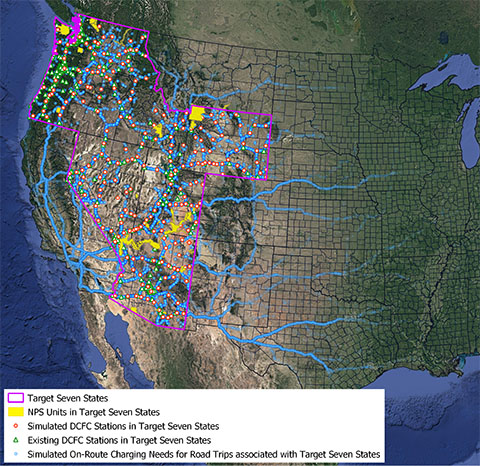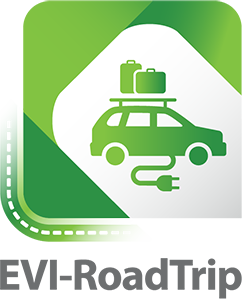NREL Study Investigates EV Fast-Charging Infrastructure Needed To Enable Travel to National Parks
NREL Analytical Tools Help Chart Course for On-Route Charging During Road Trips
From the Grand Canyon to the majestic Tetons, national parks in the western United States draw more than 80 million visitors a year. Most of these visitors rely on their personal vehicles or rentals to get them there.
Today, electric vehicles (EVs) account for more than 7% of new light-duty vehicle sales in the United States, and EV sales are expected to soar to 30%–50% by 2030. On the high end, this would translate to about 40 million light-duty EVs on the road, according to the National Renewable Energy Laboratory's (NREL's) national charging network analysis.
As EV adoption continues to grow, one source of anxiety for people traveling to the national parks or elsewhere is whether sufficient EV charging infrastructure will be available to offer them convenient and reliable charging. A recent NREL study investigated the fast-charging infrastructure needed by 2030 to enable seamless electrified road trips to and from national parks and monuments in seven western states: Washington, Oregon, Idaho, Wyoming, Utah, Nevada, and Arizona. NREL conducted the study in partnership with utility service provider PacifiCorp and Utah State University as part of the Western Smart Regional EV Adoption and Infrastructure at Scale project.
As detailed in the resulting report—"Fast-Charging Infrastructure for Electrifying Road Trips to and From National Parks in the Western United States" by NREL's Dong-Yeon Lee, Kaylyn Bopp, and Alicen Kandt—the study evaluated the quantity and location of on-route fast-charging infrastructure needed to support EV travel in and through the study area, while also estimating impacts to the electric grid.
"Travel to and from the national parks represent a distinct type of travel demand because the parks are typically located in remote areas, necessitating long road trips of 100 miles a day or more," said Lee, a research engineer and lead author of the report. "When it comes to EV charging infrastructure for road trips, direct current fast charging, or DCFC, is the most applicable solution because it enables travelers to minimize the time spent charging, providing 100–200+ miles of range in about 30 minutes with today's technology."
Analysis Results Hinge on Key Parameters
The research team investigated how on-route charging infrastructure projections change with different parameters or assumptions, as do related charging loads and grid impacts.

"Our unprecedented high-resolution spatial and temporal analysis showed that the requisite number of DCFC charging ports varies greatly—ranging from 1,200 to 22,000—depending on key assumptions," Lee said. "We also examined electrical load profiles for fast-charging infrastructure to inform electric grid operations and planning, and found that the load varies greatly, ranging from 70 MW to 400 MW."
As illustrated in the report, these large ranges hinge on key assumptions such as EV adoption (number and types of vehicles), charging behavior, average distance between charging stations, station utilization, and whether vehicles tow trailers or not.
"Planners across the country can use this type of information to better understand what is needed to enable EV road trips in their regions and beyond," said Bopp, a transportation project leader and co-author of the report. "The study shows how different assumptions result in differing degrees of impact on various aspects of charging infrastructure, illuminating the complexities that planners or decision makers must navigate when designing EV charging infrastructure for road trips."
Using the Right Tools for the Job
The analysis leveraged NREL's Electric Vehicle Infrastructure for Road Trips (EVI-RoadTrip) tool, a computational model that estimates on-route EV charging infrastructure needs for long-distance travel. EVI-RoadTrip is part of the lab's EVI-X suite of EV charging infrastructure analysis tools, which informs the planning and development of EV charging infrastructure—from the regional, state, and national levels to site and facility operations.
How EVI-RoadTrip Works

EVI-RoadTrip simulates individual road trips from origins to destinations at a high spatial (longitude and latitude) and temporal (minute-by-minute) resolution, identifies charging needs along routes, and aggregates charging demands within a certain radius to estimate charging station placement, sizing, and utilization.
By repeating this process for all road trips in a given study area, EVI-RoadTrip develops a proposed network of fast-charging stations that provide sufficient coverage and capacity. It also estimates electricity needs based on the projected charging station locations and characteristics.
The analysis also tapped into drive cycle data from NREL's Transportation Secure Data Center as well as the vehicle simulation capabilities of NREL's Future Automotive Systems Technology Simulator.
NREL has partnered with the National Park Service for more than a decade, supporting its vision for attaining net-zero emissions throughout the park system. This study exemplifies one of the ways that NREL can help make travel to and from the parks more sustainable for all.
Learn more about NREL's sustainable transportation and mobility research. And sign up for NREL's quarterly transportation and mobility research newsletter, Sustainable Mobility Matters, to stay current on the latest news.
